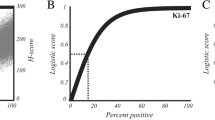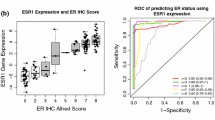Abstract
Several prognostic indices in breast cancer, including c-erbB2, epithelial growth factor receptors (EGFR), estrogen and progesterone receptors are signal transduction molecules. Recently, expression of another signal transduction molecule, the protein tyrosine phosphatase LAR, has been suggested to be increased in breast cancer. The objective of the current investigation was to examine the relationship between LAR expression and prognostic parameters in breast cancer. LAR expression was associated with metastatic potential in the well-characterized 13762NF rat mammary adenocarcinoma clones. The metastatic MTLn3 and MTLn2 clones expressed sizable amounts of LAR. The essentially non-metastatic MTC clone had little LAR expression. C-erbB2 had highest expression in the highly metastatic MTLn3 clone, but c-erbB2 levels were sizeable in the weakly metastatic MTLn2 and non-metastatic MTC clone. EGFR expression had the strongest association with a clone's metastatic potential, being very high in MTLn3, weak in MTLn2, and undetectable in MTC. In human breast cancer specimens, LAR expression was strongly positive in 50% of metastatic cases but in only 21% of ‘non-metastatic’ cases. As with the 13762NF-derived clones, c-erbB2 expression was strongly positive independent of metastatic phenotype. However, 46% (6/13) of cases that were strongly positive for c-erbB2 were strongly positive for LAR. Only 17% (2/11) of negative or weakly c-erbB2 positive samples were strongly positive for LAR. All ER+ positive tumors (n = 15) were positive for LAR and 53% of these tumors were strongly positive for LAR. In ER− negative cases, only 1 of 11 was strongly positive for LAR. While the current data indicate a strong association between ER and LAR expression in breast cancer tissue (p = 0.003), additional studies are warranted to further explore the relationship between LAR and prognostic indices of breast cancer progression.
Similar content being viewed by others
References
Mills RR, Hanby AM, Oberman HA: The breast. In: Sternberg S.S. (ed), Diagnostic Surgical Pathology. Lippincott, Williams, and Wilkins, Philadelphia, 1999, pp. 319–385
Landis SH, Murray T, Bolden S, Wingo PA: Cancer statistics, 1999. Ca: Cancer J Clin 49: 8–31, 1999
Elston CW, Ellis IO: Pathological prognostic factors in breast cancer. I. The value of histologic grade in breast cancer: Experience from a large study with long-term follow-up. Histopathology 19: 403–410, 1991
Yang T, Zhang JS, Massa SM, Han X, Longo FM: Leukocyte common antigen-related tyrosine phosphatase receptor: Increased expression and neuronal-type splicing in breast cancer cells and tissue. Mol Carcino 25: 139–149, 1999
Streuli M, Krueger NX, Hall LR, Schlossman SF, Saito H: A new member of the immunoglobulin superfamily that has a cytoplasmic region homologous to the leukocyte common antigen. J Exp Med 168: 1523–1531, 1988
O'Grady P, Thai TC, Saito H: The laminin-nidogen complex is a ligand for a specific splice isoform of the transmembrane protein tyrosine phosphatase LAR. J Cell Biol 141: 1675–1684, 1998
Kulas DT, Goldstein BJ, Mooney RA: The transmembrane protein-tyrosine phosphatase LAR modulates signaling by multiple receptor tyrosine kinases. J Biol Chem 271: 748–754, 1996
Zhang WR, Li PM, Oswald MA, Goldstein BA: Modulation of insulin signal transduction by eutopic overexpression of the receptor-type protein-tyrosine phosphatase LAR. Mol Endo 10: 575–584, 1996
Serra-Pages C, Kedersha NL, Fazikas L, Medley Q, Debant A, Streuli M: The LAR transmembrane protein tyrosine phosphatase and a coiled-coil LAR-interacting protein co-localize at focal adhesions. EMBO J 14: 2827–2838, 1995
Kypta RM, Su H, Reichardt LF: Association between a transmembrane protein tyrosine phosphatase and the cadherincatenin complex. J Cell Biol 134: 1519–1529, 1996
Aicher B, Lerch MM, Muller T, Schilling J, Ullrich A: Cellular redistribution of protein tyrosine phosphatases LAR and PTPs by inducible proteolytic processing. J Cell Biol 138: 681–696, 1997
Schaapveld RQJ, Schepens JTG, Robinson GW, Attema J, Oerlemans FTJJ, Fransen JAM, Streuli M, Wieringa B, Hennighausen L, Hendriks WJAJ: Impaired mammary gland development and function in mice lacking LAR receptorlike tyrosine phosphatase activity. Dev Biol 188: 134–136, 1997
Pulido R, Serra-Pages C, Tang M, Streuli M: The LAR/PTPδ/PTPσ subfamily of transmembrane proteintyrosine-phosphatases: Multiple human LAR, PTPδ, and PTPσ isoforms are expressed in a tissue-specific manner and associate with the LAR-interacting protein LIP.1. Proc Natl Acad Sci USA 92: 11686–11690, 1995
Neri A, Welch D, Kawaguchi T, Nicolson GL: Development and biologic properties of malignant cell sublines and clones of a spontaneously metastasizing rat mammary adenocarcinoma. JNCI 68: 507–517, 1982
Nicolson G: Differential organ tissue adhesion, invasion, and growth properties of metastatic rat mammary adenocarcinoma cells. Breast Cancer Res Treat 12: 167–176, 1988
Zhai YF, Beittenmiller H, Wang B, Gould MN, Oakley C, Esselman WJ, Welsch CW: Increased expression of specific protein tyrosine phosphatases in human breast epithelial cells neoplastically transformed by the neu oncogene. Cancer Res 53: 2272–2278, 1993
Lichtner RB, Kaufmann AM, Kittmann A, Rohde-Schulz B, Walter J, Williams L, Ullrich A, Schirrmacher V, Khazaie K: Ligand mediated activation of ectopic EGF receptor promotes matrix protein adhesion and lung colonization of rat mammary adenocarcinoma cells. Oncogene 10: 1823–1832, 1995
Kaufmann, AM, Lichtner RB, Schirrmacher V, Khazaie, K: Induction of apoptosis by EGF receptor in rat mammary adenocarcinoma cells coincides with enhanced spontaneous tumour metastasis. Oncogene 13: 2349–2358, 1996
Hynes NE, Stein DF: The biology of erbB-2/neu/HER-2 and its role in cancer. Biochim Biophys Acta 1198: 165–184, 1994
Slamon DJ, Clark GM, Wong SG, Levin WJ, Ulrich A, McGuire WL: Human breast cancer: correlation of relapse and survival with amplification of the HER-2/neu oncogene. Science 235: 177–182, 1987
Knight WA, Livingston RB, Gregory EJ, McGuire WL: Estrogen receptors as an independent progostic factor for early recurrence in breast cancer. Cancer Res 37: 4669–4671, 1977
Glick JH: Consensus conference: Adjuvant chemotherapy for breast cancer. J Am Med Assn 254: 3461–3463, 1985
Ottenhoff-Kalff, AE, van Oirschot BA, Hennipman A, de Weger RA, Staal GE, Rijksen G: Protein tyrosine phosphatase activity as a diagnostic parameter in breast cancer. Breast Can Res Treat 33: 245–246, 1995
Partanen S: Histochemically demonstrable protein tyrosine phosphastase in human breast and colorectal cancer: large decrease in its activity in colorectal cancer suggests a tumor suppressor role in colorectal mucosal cells. Anticancer Res 16: 943–946, 1996
Resnik JL, Reichart DB, Huey K, Webster N, Seely BL: Elevated insulin-like growth factor I receptor autophosphorylation and kinase activity in human breast cancer. Can Res 58: 1159–1164, 1998
Freiss G, Puech C, Vignon F: Extinction of insulin-like growth factor-I mitogenic signaling by antiestrogen-stimulated fasassociated protein tyrosine phosphatase-1 in human breast cancer cells. Mol Endo 12: 568–579, 1998
Fleiss JL: Statistical Methods for Rates and Proportions. Wiley 2nd Edn, New York, 1981
Muller T, Choidas A, Reichmann E, Ullrich A: Phosphorylation and free pool of beta-catenin are regulated by tyrosine kinases and tyrosine phosphatases during epithelial cell migration. J Biol Chem 274: 10173–10183, 1999
Author information
Authors and Affiliations
Rights and permissions
About this article
Cite this article
LeVea, C.M., McGary, C.T., Symons, J.R. et al. PTP LAR Expression Compared to Prognostic Indices in Metastatic and Non-Metastatic Breast Cancer. Breast Cancer Res Treat 64, 221–228 (2000). https://doi.org/10.1023/A:1006410509740
Issue Date:
DOI: https://doi.org/10.1023/A:1006410509740




